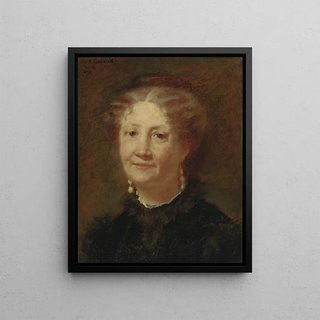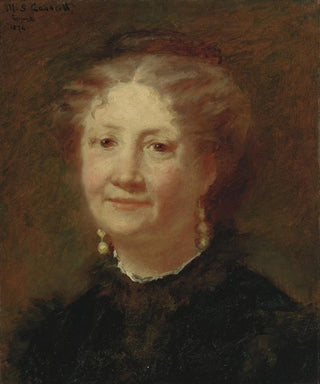Art print | Portrait of Mrs. Cortier - Mary Cassatt


View from behind

Frame (optional)
Portrait of Mme Cortier - Mary Cassatt – Captivating Introduction
The "Portrait of Mme Cortier" by Mary Cassatt is set within a pivotal period in art history, where artists sought to capture not only physical resemblance but also the very essence of their subjects. This work, imbued with delicacy and sensitivity, demonstrates Cassatt's mastery in portrait art, while highlighting themes of intimacy and femininity. By immersing oneself in this painting, viewers are invited to discover a world where inner and outer beauty converge, revealing an emotional depth that transcends mere painting.
Style and uniqueness of the work
Mary Cassatt's style, influenced by Impressionism, is characterized by a subtle use of color and light. In the "Portrait of Mme Cortier," delicate brushstrokes and pastel shades create a soft, soothing atmosphere. The artist manages to capture not only the distinctive features of her model but also an expression of serenity and confidence. The composition, carefully balanced, emphasizes Mme Cortier's penetrating gaze, which seems to invite the viewer to share a moment of intimacy. Cassatt's play with shadows and light enhances this sense of closeness, making the portrait almost alive. Every detail, from the fabric of the dress to the reflections in the hair, is treated with meticulous attention, making this work a perfect example of her artistic approach.
The artist and her influence
Mary Cassatt, an emblematic figure of the Impressionist movement, established herself in a male-dominated environment. Born in 1844, she dedicated her career to exploring the female condition through her art, highlighting women's experiences and emotions. Her friendship with masters such as Degas enriched her work, allowing her to refine her style and broaden her artistic horizons. Cassatt did not only paint portraits; she also played a crucial role in promoting female art, encouraging other women to express themselves through painting. Her influence endures today, inspiring new generations of artists to address similar themes.

Matte finish

View from behind

Frame (optional)
Portrait of Mme Cortier - Mary Cassatt – Captivating Introduction
The "Portrait of Mme Cortier" by Mary Cassatt is set within a pivotal period in art history, where artists sought to capture not only physical resemblance but also the very essence of their subjects. This work, imbued with delicacy and sensitivity, demonstrates Cassatt's mastery in portrait art, while highlighting themes of intimacy and femininity. By immersing oneself in this painting, viewers are invited to discover a world where inner and outer beauty converge, revealing an emotional depth that transcends mere painting.
Style and uniqueness of the work
Mary Cassatt's style, influenced by Impressionism, is characterized by a subtle use of color and light. In the "Portrait of Mme Cortier," delicate brushstrokes and pastel shades create a soft, soothing atmosphere. The artist manages to capture not only the distinctive features of her model but also an expression of serenity and confidence. The composition, carefully balanced, emphasizes Mme Cortier's penetrating gaze, which seems to invite the viewer to share a moment of intimacy. Cassatt's play with shadows and light enhances this sense of closeness, making the portrait almost alive. Every detail, from the fabric of the dress to the reflections in the hair, is treated with meticulous attention, making this work a perfect example of her artistic approach.
The artist and her influence
Mary Cassatt, an emblematic figure of the Impressionist movement, established herself in a male-dominated environment. Born in 1844, she dedicated her career to exploring the female condition through her art, highlighting women's experiences and emotions. Her friendship with masters such as Degas enriched her work, allowing her to refine her style and broaden her artistic horizons. Cassatt did not only paint portraits; she also played a crucial role in promoting female art, encouraging other women to express themselves through painting. Her influence endures today, inspiring new generations of artists to address similar themes.






